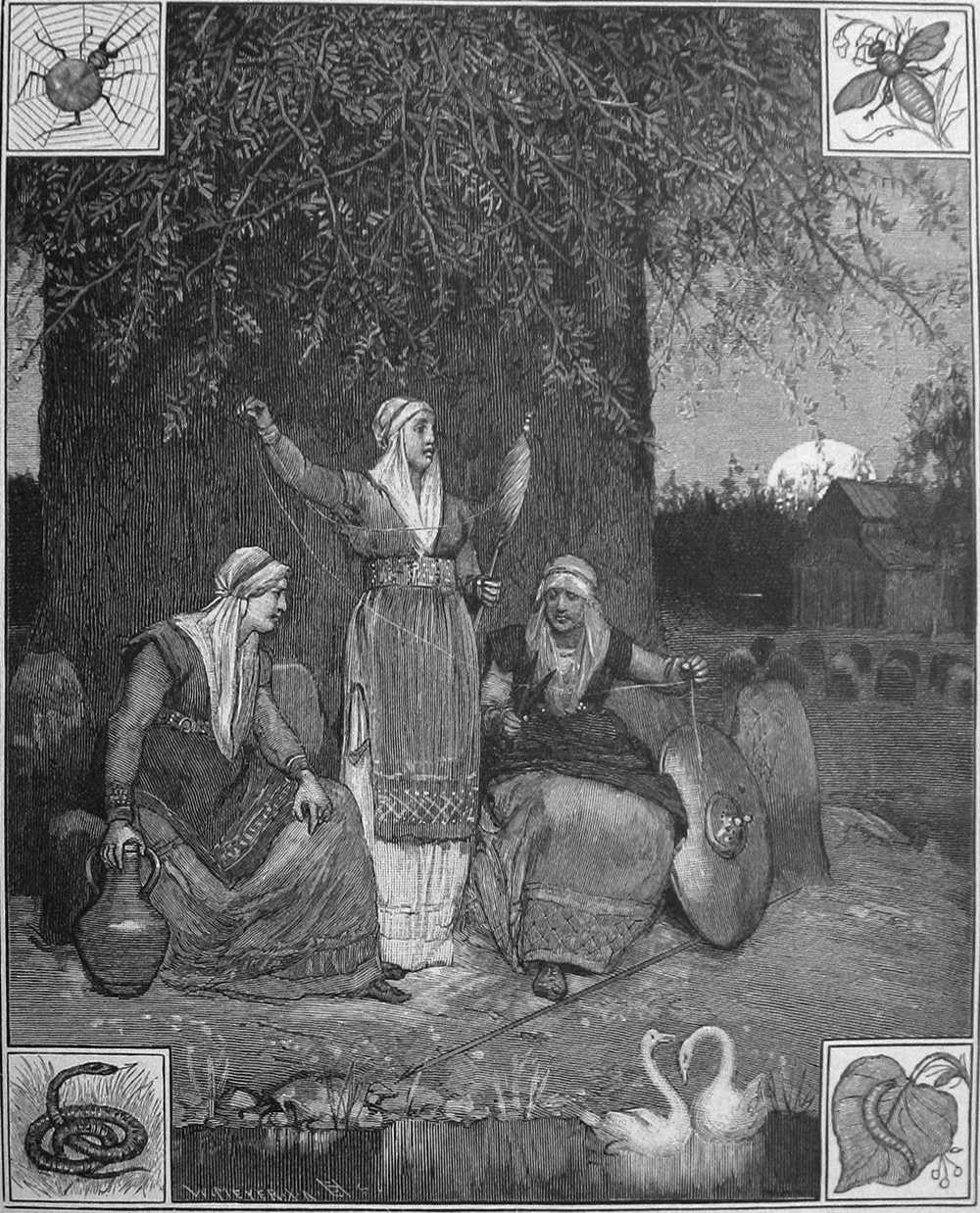
World of Myth
The NornsThe Norns Fast Facts
The Norns spin the threads of fate at the foot of Yggdrasil, the tree of the world. Beneath them is the well Urðarbrunnr with the two swans that have engendered all the swans in the world. (Creative Commons)
Domain: The Norns watch over and weave destiny and the fate of men (and gods).
Type of Being: Spirits named Urd (Past), Verdandi (Present), and Skuld (Future)
Powers: Measuring and controlling time, monitoring the fate of humans
Place: Around the base of Yggdrasil by the Urdarbrunn (Well of Urd). Some versions have the Norns exiting a hall; other tellings have them emerging from a lake at the beginning of time.
Associated Animals: Swans and spiders (the Norns can appear as spinners)
Appearance: Usually maidens, Skuld is sometimes depicted as veiled
Significant Items: Thread
Primary Texts: Gylfaginning in the Prose Edda, Voluspa in the Poetic Edda
The Norns Student Research
The Norns, or Nornir, have no kinship between them and any other being in Norse mythology. They are their own entire entity. Secondary Online sources such as the Brooklyn Museum will say that they are sisters to one another whilst the Eddas will state that each Norn is their own individual being. There was no evidence that they were ever worshiped like other gods, either.
Who are the Norns?
The Norns (Nornir) are 3 spirits of destiny:
Urd – That Which Has Happened, Fate, Past
Verdandi – That Which Is Happening, Present, Becoming
Skuld – That Which Shall Happen, Future, Obligation
– Norse Mythology A to Z, Kathleen N. Daly
–The Prose Edda, Snorri Sturluson
Select Norns Myth

Reusch, Rudolf Friedrich. 1865. Die nordischen Göttersagen. (Creative Commons)
The Norns at Yggadrasil
There stands a beautiful hall near the fountain beneath the ash. Out of it come three maids, whose names are Urd, Verdande and Skuld. These maids shape the lives of men, and we call them norns. There are yet more norns, namely those who come to every man when he is born, to shape his life, and these are known to be of the race of gods; others, on the other hand, are of the race of elves, and yet others are of the race of dwarfs. As is here said:
Far asunder, I think,
The norns are born,
They are not of the same race.
Some are of the asas,
Some are of the elves,
Some are daughters of Dvalin.
Then said Ganglere: If the norns rule the fortunes of men, then they deal them out exceedingly unevenly. Some live a good life and are rich; some get neither wealth nor praise. Some have a long, others a short life. Har answered: Good norns and of good descent shape good lives, and when some men are weighed down with misfortune, the evil norns are the cause of it.
–Sturluson, Snorri. The Younger Edda; Also Called Snorre’s Edda, or The Prose Edda.
Conflation, Synchronicity, and the Triple Goddess
The Norns are more personifications of ideas than stand-alone deities with distinct personalities (like Odin). They are usually at the periphery of stories, serving to offer guidance to the hero as opposed to being the heroes (heroines) themselves.
They are often viewed as an example of the “Triple Goddess”, an archetypal grouping of deities. Ideas of the triple goddess are not settled in scholarship and considered by some to be spurious. The recording of Norse mythology by medieval Christian monks makes it difficult to discern the true nature of the Norns separate from the Greek Moirai or Roman Parcae (who would have been well known by the monks recording the Norse mythology).
Ancient Greek Mythology
The Moirai (The Apportioners)
- Clotho – the Spinner of the thread
- Lachesis – the Measurer of the thread (alloter)
- Atropos – the Cutter of the thread (the unturned) who is associated with Death
The Moirai are sometimes confused with the Furies / Eumenides (aka the Kindly Ones) who pursue those guilty of blood crimes. They are also three women, who operate with power outside/beyond the other gods. Their best-known story is the Oresteia, which is the trial of Orestes.
Heacte is a triple goddess whose first appearance in literature is in the Theogony by Hesiod in the 8th century BCE. She is commonly the goddess of crossroads who has domains in the earth, sea, and sky.
Roman Mythology
The Parcae (Sparing Ones) were originally goddesses of childbearing, these goddesses merged with the Greek Moirai.
- Nona – the ninth
- Decuma – the tenth
- Morta – the dead

Drawing of a Hekataion. (Creative Commons)
Resources
Norse Sources
Lindow, John. Old Norse Mythology. New York, NY: Oxford University Press, 2021.
General Sources


